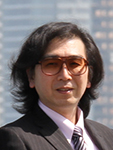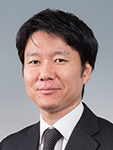
- Dr. Fabrizio Dabbene (Senior Researcher, CNR-IEIIT, Italy)
- Prof. Yoshiyuki Sankai (CEO, CYBERDYNE Inc., Prof., Univ. of Tsukuba, Japan)
- Prof. Takayuki Okatani (Prof., Tohoku Univ., Japan)
Plenary Talk I
Fabrizio Dabbene, Ph.D.
Senior Researcher, CNR-IEIIT, Italy
Coping in an efficient way with uncertainty represents one of the key issues in modern control design. In recent years, a novel approach based on probability and randomization has emerged to synergize with the standard deterministic methods for control of systems with uncertainty. In this lecture, we will show how the right combination of uncertainty randomization and convex optimization can lead to design solutions which are reliable, without being overly conservative. We will analyze the main technical tools at the basis of randomized algorithm for control, and provide a brief overview of different applications areas, ranging from anti-windup design, to robust model predictive control and smart grid and multi-stage optimization.
 Biography: Fabrizio Dabbene received the Laurea degree in 1995 and the Ph.D. degree in Systems and Computer Engineering in 1999, both from Politecnico di Torino, Italy. Since 2001 he is with the IEIIT institute of the National Research Council (CNR) of Italy, where he is currently a Senior Researcher. He has held visiting and research positions at The University of Iowa, at Penn State University and at the Institute of Control Science of the Russian Academy of Sciences, Moscow.
Biography: Fabrizio Dabbene received the Laurea degree in 1995 and the Ph.D. degree in Systems and Computer Engineering in 1999, both from Politecnico di Torino, Italy. Since 2001 he is with the IEIIT institute of the National Research Council (CNR) of Italy, where he is currently a Senior Researcher. He has held visiting and research positions at The University of Iowa, at Penn State University and at the Institute of Control Science of the Russian Academy of Sciences, Moscow.
His research interests include probabilistic and randomized methods for systems and control, robust control and identification of complex systems, convex optimization and modeling of smart grids and environmental systems. On these topics, he has published more than 100 research papers and two books, and he is recipient of the 2010 EurAgeng Outstanding Paper Award.
Dr. Dabbene is a Senior Member of the IEEE. He has been an Associate Editor for the IEEE Transactions on Automatic Control (2008-2012) and for Automatica (2008-2014), Program Chair for the CACSD Symposium of the 2010 IEEE MSC, Chair of the IEEE Technical Committee on CACSD (2010-2013) and of the IFAC Technical Committee on Robust Control (2011-present), member of the Conference Editorial Board (2002-2008) and IPC member of various IEEE conferences. He is elected member of the IEEE-CSS Board of Governors for the years 2014-2016, and serves as IEEE-CSS Vice-President for Publication Activities for the years 2015-2016.
URL: http://www.sct.ieiit.cnr.it/fabrizio.dabbene.php
Plenary Talk II
Yoshiyuki Sankai, Ph.D.
President and CEO of CYBERDYNE, Inc; Professor and the Director at the Center for Cybernics Research, University of Tsukuba; ImPACT Program Manager, the Council for Science, Technology and Innovation (CSTI) of the Cabinet Office
As a pioneer in innovative cyborg-type robot technology, I have developed a new academic field, “Cybernics: the fusion and combination of humans, machines and information systems”, and established a social problem-solving venture company, CYBERDYNE Inc. I led the intellectual property strategy and international standard setting by the ISO as an expert member of the committee on the field of medical robots and personal-care robots. Our medical device HAL® acquired the CE marking certificate (CE0197) in August 2013 and its use as a medical treatment is being covered by public workers’ compensation insurance in Germany. This feat was followed by an approval from the Ministry of Health, Labour and Welfare in Japan to manufacture and distribute this new medical device on November 2015. HAL® improves physical functions of patients and is used in medical treatment to delay the advancement of slowly progressive rare neuromuscular diseases, for which coverage by Japan’s public health insurance was decided in January 2016.
 Biography: Yoshiyuki Sankai acquired a Ph.D. in Engineering from the University of Tsukuba, Japan, in 1987. He has progressed from being Research Fellow of Japan Society for the Promotion of Science (JSPS), to Assistant Professor, Associate Professor, and Professor at the Graduate School of Systems and Information Engineering, University of Tsukuba. Dr. Sankai is also a Visiting Professor at Baylor College of Medicine, Houston, Texas, United States. Currently, he is a Professor and the Director at the Center for Cybernics Research, University of Tsukuba, the President and CEO of CYBERDYNE Inc., and a Program Manager of the Impulsing Paradigm Change through Disruptive Technologies (ImPACT) Program, initiated by the Council for Science, Technology and Innovation (CSTI) of the Cabinet Office, Japan.
Biography: Yoshiyuki Sankai acquired a Ph.D. in Engineering from the University of Tsukuba, Japan, in 1987. He has progressed from being Research Fellow of Japan Society for the Promotion of Science (JSPS), to Assistant Professor, Associate Professor, and Professor at the Graduate School of Systems and Information Engineering, University of Tsukuba. Dr. Sankai is also a Visiting Professor at Baylor College of Medicine, Houston, Texas, United States. Currently, he is a Professor and the Director at the Center for Cybernics Research, University of Tsukuba, the President and CEO of CYBERDYNE Inc., and a Program Manager of the Impulsing Paradigm Change through Disruptive Technologies (ImPACT) Program, initiated by the Council for Science, Technology and Innovation (CSTI) of the Cabinet Office, Japan.
Plenary Talk III
Takayuki Okatani, Dr Eng.,
Professor, Tohoku University
Deep learning has completely changed the shape of the field of computer vision for the last several years. For these years, convolutional neural networks (CNNs), the best performing model of deep neural networks (DNNs) for computer vision, have been applied to all sorts of visual recognition tasks. They have advanced the state-of-the-art for most of the tasks, for a few of which their performances have even surpassed human vision. That said, CNNs do not always yield as good performance as human. In fact, they show only moderate or even no improvement over former state-of-the-art for a few specific tasks. In this talk, I will first summarize for which tasks CNNs are effective and for which they are not. I will discuss why such differences emerge by introducing recent studies in neuroscience that compare visual cortex with CNNs in their signal level, which are being conducted to better understand how visual information is processed in our brain and CNNs. Next, I will give a brief survey of recently developed methods for training DNNs, including a method proposed by my research group, where the focus will be on how to control redundancy existing in the weights of DNNs. Finally, I will introduce our recent studies of application of CNNs to problems of predicting material categories and perceptual surface qualities of an object from its single image.
 Biography: He is a Professor at the Graduate School of Information Sciences of Tohoku University, where he leads the Image Analysis Lab. He received his doctorate degree in Engineering from the University of Tokyo in 1999. He then worked as a Research Associate at Tohoku University and become a Professor since 2013. His areas of research are computer vision and image processing. He currently serves as an associate Editor of International Journal of Computer Vision.
Biography: He is a Professor at the Graduate School of Information Sciences of Tohoku University, where he leads the Image Analysis Lab. He received his doctorate degree in Engineering from the University of Tokyo in 1999. He then worked as a Research Associate at Tohoku University and become a Professor since 2013. His areas of research are computer vision and image processing. He currently serves as an associate Editor of International Journal of Computer Vision.
Deadline of Proposal of Workshops and Tutorials (extended)
Deadline of Proposal of Organized Sessions (extended)
Deadline of Submission for Regular Papers(extended) and Position Papers (4/22)
Notification of Paper Acceptance (July 1, 2016: Submission of Final Camera-ready Papers)